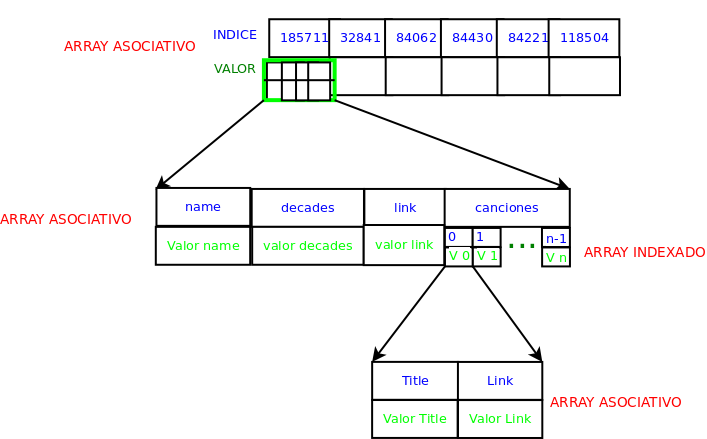Diferencia entre revisiones de «Usuario:ManuelRomero/php/arrayys/ejercicios»
De WikiEducator
< Usuario:ManuelRomero | php
| (8 revisiones intermedias por el mismo usuario no mostrado) | |||
| Línea 1: | Línea 1: | ||
__NOTOC__ | __NOTOC__ | ||
{{:Usuario:ManuelRomero/php/arrays/nav}} | {{:Usuario:ManuelRomero/php/arrays/nav}} | ||
| − | + | {{Actividad|Title=Array de 5 ciudades| | |
| + | Crea un array indexado con 5 valores de ciudades y recórrelo con un for}} | ||
<hr/> | <hr/> | ||
<source lang=php> | <source lang=php> | ||
| Línea 20: | Línea 21: | ||
?> | ?> | ||
</source> | </source> | ||
| − | + | {{MRM_Actividad|Crea un array con 10 notas aleatorias y posteriormente las visualizas obteniendo los valores estadísticos de la media, máxima y mínima}} | |
<hr/> | <hr/> | ||
| + | <source lang=php> | ||
| + | <?php | ||
| + | |||
| + | $notas = array(); | ||
| + | $tamano = rand(1,50); | ||
| + | //Ahora rellenamos el valor de $tamano posiciones del vector | ||
| + | for ($n=0; $n<$tamano;$n++){ | ||
| + | $notas[$n] = rand(1,10); | ||
| + | } | ||
| + | //recorremos calculando minimo, maximo y media | ||
| + | |||
| + | //El primer valor del vector inicializa las variables | ||
| + | $min = $notas[0]; | ||
| + | $max = $notas[0]; | ||
| + | $suma = $notas[0]; | ||
| + | for ($n=1; $n<count($notas) ;$n++){ | ||
| + | if ($min>$notas[$n]) | ||
| + | $min=$notas[$n]; | ||
| + | if ($max<$notas[$n]) | ||
| + | $max=$notas[$n]; | ||
| + | $suma+=$notas[$n]; | ||
| + | } | ||
| + | echo "La nota máxima es $max<br>"; | ||
| + | echo "La nota mínima es $min<br>"; | ||
| + | echo "La nota media es es". ($suma/$n); | ||
| + | |||
| + | ?> | ||
| + | |||
| + | </source> | ||
| + | |||
| + | {{MRM_Actividad|Crea un array con imagenes aleatorias y luego haz que se carguen cada 5 segundos de forma aleatoria}} | ||
| + | {{Tip|Para recargar de forma periódica la página pasados unos segundos podemos usar el meta de html | ||
| + | <source lang=html5> | ||
| + | <META HTTP-EQUIV=Refresh CONTENT="5; URL=vuestra_pagina.php"> | ||
| + | </source> | ||
| + | }}}} | ||
| + | |||
| + | <source lang=php> | ||
| + | <!DOCTYPE html> | ||
| + | <!-- | ||
| + | To change this license header, choose License Headers in Project Properties. | ||
| + | To change this template file, choose Tools | Templates | ||
| + | and open the template in the editor. | ||
| + | --> | ||
| + | <html> | ||
| + | <head> | ||
| + | <meta charset="UTF-8"/> | ||
| + | <meta http-equiv="refresh" content="5" url="index.php"/> | ||
| + | <title></title> | ||
| + | </head> | ||
| + | <body> | ||
| + | <?php | ||
| + | $imagenes = array( | ||
| + | "http://www.tecn.upf.es/~ocelma/cpom/practicas/php/random_images/discography/a_piece_for_the_wicked_vol_1.jpg", | ||
| + | "http://www.tecn.upf.es/~ocelma/cpom/practicas/php/random_images/discography/double_t.jpg", | ||
| + | "http://www.tecn.upf.es/~ocelma/cpom/practicas/php/random_images/discography/flagrantly_yours.jpg", | ||
| + | "http://www.tecn.upf.es/~ocelma/cpom/practicas/php/random_images/discography/gothic.jpg", | ||
| + | "http://www.tecn.upf.es/~ocelma/cpom/practicas/php/random_images/discography/iliad_of_a_wolverhampton_wanderer.jpg", | ||
| + | "http://www.tecn.upf.es/~ocelma/cpom/practicas/php/random_images/discography/libertine.jpg", | ||
| + | "http://www.tecn.upf.es/~ocelma/cpom/practicas/php/random_images/discography/lullabies_for_tough_guys.jpg", | ||
| + | "http://www.tecn.upf.es/~ocelma/cpom/practicas/php/random_images/discography/nocturnal_nomad.jpg", | ||
| + | "http://www.tecn.upf.es/~ocelma/cpom/practicas/php/random_images/discography/the_idle_gait_of_the_self_possessed.gif", | ||
| + | "http://www.tecn.upf.es/~ocelma/cpom/practicas/php/random_images/discography/the_life_and_times_of_a_ballad_monger.jpg" | ||
| + | ); | ||
| + | $n1=rand(0,9); | ||
| + | $n2=rand(0,9); | ||
| + | $n3=rand(0,9); | ||
| + | echo "<img src=$imagenes[$n1]><img src=$imagenes[$n2]><img src=$imagenes[$n3]>"; | ||
| + | ?> | ||
| + | </body> | ||
| + | </html> | ||
| + | </source> | ||
| + | {{Actividad|Analizar un array complejo}} | ||
| + | *Dado el siguiente fichero realiza un estudio de cómo es ese array | ||
| + | [[Medio:array.pdf]] | ||
| + | *Solución | ||
| + | *Podemos ver que se trata de un array asociativo con 6 elementos según se muestra en la figura | ||
| + | [[Imagen:ArrayComplejo.png]] | ||
Última revisión de 07:08 4 nov 2016
<?php //defino e inicializo el vector $ciudades[0]="Valencia"; $ciudades[]="Teruel"; $ciudades[]="Burgos"; $ciudades[]="Zaragoza"; $ciudades[]="Huesca"; //Obtengo el número de elementos $num= count($ciudades); echo "hay $num ciudades"; for ($n=0; $n<$num; $n++){ echo "ciudad $n es $ciudades[$n]<br>"; } ?>
<?php $notas = array(); $tamano = rand(1,50); //Ahora rellenamos el valor de $tamano posiciones del vector for ($n=0; $n<$tamano;$n++){ $notas[$n] = rand(1,10); } //recorremos calculando minimo, maximo y media //El primer valor del vector inicializa las variables $min = $notas[0]; $max = $notas[0]; $suma = $notas[0]; for ($n=1; $n<count($notas) ;$n++){ if ($min>$notas[$n]) $min=$notas[$n]; if ($max<$notas[$n]) $max=$notas[$n]; $suma+=$notas[$n]; } echo "La nota máxima es $max<br>"; echo "La nota mínima es $min<br>"; echo "La nota media es es". ($suma/$n); ?>
Tip: Para recargar de forma periódica la página pasados unos segundos podemos usar el meta de html
<META HTTP-EQUIV=Refresh CONTENT="5; URL=vuestra_pagina.php">}}
<!DOCTYPE html>
<!--
To change this license header, choose License Headers in Project Properties.
To change this template file, choose Tools | Templates
and open the template in the editor.
-->
<html>
<head>
<meta charset="UTF-8"/>
<meta http-equiv="refresh" content="5" url="index.php"/>
<title></title>
</head>
<body>
<?php
$imagenes = array(
"http://www.tecn.upf.es/~ocelma/cpom/practicas/php/random_images/discography/a_piece_for_the_wicked_vol_1.jpg",
"http://www.tecn.upf.es/~ocelma/cpom/practicas/php/random_images/discography/double_t.jpg",
"http://www.tecn.upf.es/~ocelma/cpom/practicas/php/random_images/discography/flagrantly_yours.jpg",
"http://www.tecn.upf.es/~ocelma/cpom/practicas/php/random_images/discography/gothic.jpg",
"http://www.tecn.upf.es/~ocelma/cpom/practicas/php/random_images/discography/iliad_of_a_wolverhampton_wanderer.jpg",
"http://www.tecn.upf.es/~ocelma/cpom/practicas/php/random_images/discography/libertine.jpg",
"http://www.tecn.upf.es/~ocelma/cpom/practicas/php/random_images/discography/lullabies_for_tough_guys.jpg",
"http://www.tecn.upf.es/~ocelma/cpom/practicas/php/random_images/discography/nocturnal_nomad.jpg",
"http://www.tecn.upf.es/~ocelma/cpom/practicas/php/random_images/discography/the_idle_gait_of_the_self_possessed.gif",
"http://www.tecn.upf.es/~ocelma/cpom/practicas/php/random_images/discography/the_life_and_times_of_a_ballad_monger.jpg"
);
$n1=rand(0,9);
$n2=rand(0,9);
$n3=rand(0,9);
echo "<img src=$imagenes[$n1]><img src=$imagenes[$n2]><img src=$imagenes[$n3]>";
?>
</body>
</html>
- Dado el siguiente fichero realiza un estudio de cómo es ese array
- Solución
- Podemos ver que se trata de un array asociativo con 6 elementos según se muestra en la figura

